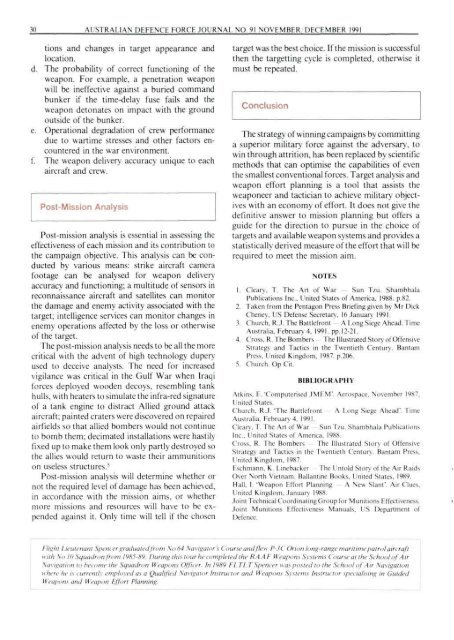ISSUE 91 : Nov/Dec - 1991 - Australian Defence Force Journal
ISSUE 91 : Nov/Dec - 1991 - Australian Defence Force Journal
ISSUE 91 : Nov/Dec - 1991 - Australian Defence Force Journal
Create successful ePaper yourself
Turn your PDF publications into a flip-book with our unique Google optimized e-Paper software.
30 AUSTRALIAN DEFENCE FORCF JOURNAL NO. <strong>91</strong> NOVEMBER DECEMBER 19<strong>91</strong><br />
tions and changes in target appearance and<br />
location.<br />
The probability of correct functioning of the<br />
weapon. For example, a penetration weapon<br />
will be ineffective against a buried command<br />
bunker if the time-delay fuse fails and the<br />
weapon detonates on impact with the ground<br />
outside of the bunker.<br />
Operational degradation of crew performance<br />
due to wartime stresses and other factors encountered<br />
in the war environment.<br />
The weapon delivery accuracy unique to each<br />
aircraft and crew.<br />
Post-Mission Analysis<br />
Post-mission analysis is essential in assessing the<br />
effectiveness of each mission and its contribution to<br />
the campaign objective. This analysis can be conducted<br />
by various means: strike aircraft camera<br />
footage can be analysed for weapon delivery<br />
accuracy and functioning; a multitude of sensors in<br />
reconnaissance aircraft and satellites can monitor<br />
the damage and enemy activity associated with the<br />
target; intelligence services can monitor changes in<br />
enemy operations affected by the loss or otherwise<br />
of the target.<br />
The post-mission analysis needs to be all the more<br />
critical with the advent of high technology duperyused<br />
to deceive analysts. The need for increased<br />
vigilance was critical in the Gulf War when Iraqi<br />
forces deployed wooden decoys, resembling tank<br />
hulls, with heaters to simulate the infra-red signature<br />
of a tank engine to distract Allied ground attack<br />
aircraft: painted craters were discovered on repaired<br />
airfields so that allied bombers would not continue<br />
to bomb them; decimated installations were hastily<br />
fixed up to make them look only partly destroyed so<br />
the allies would return to waste their ammunitions<br />
on useless structures. 5<br />
Post-mission analysis will determine whether or<br />
not the required level of damage has been achie\ed,<br />
in accordance with the mission aims, or whether<br />
more missions and resources will have to be expended<br />
against it. Only time will tell if the chosen<br />
target was the best choice. If the mission is successful<br />
then the targetting cycle is completed, otherwise it<br />
must be repeated.<br />
Conclusion<br />
The strategy of winning campaigns by committing<br />
a superior military force against the adversary, to<br />
win through attrition, has been replaced by scientific<br />
methods that can optimise the capabilities of even<br />
the smallest conventional forces. Target analysis and<br />
weapon effort planning is a tool that assists the<br />
weaponeer and tactician to achieve military objectives<br />
with an economy of effort. It does not give the<br />
definitive answer to mission planning but offers a<br />
guide for the direction to pursue in the choice of<br />
targets and available weapon systems and provides a<br />
statistically derived measure of the effort that will be<br />
required to meet the mission aim.<br />
NOTES<br />
1. Geary. T. The Art of War Sun Tzu. Shambhala<br />
Publications Inc., United States of America, 1988. p.82.<br />
2. Taken from the Pentagon Press Briefing given by Mr Dick<br />
Cheney. US Defense Secretary, 16 January 19<strong>91</strong>.<br />
3. Church. R..I. The Battlefront A Long Siege Ahead. Time<br />
Australia, February 4, 19<strong>91</strong>. pp. 12-21.<br />
4. Cross, R. The Bombers The Illustrated Story of Offensive<br />
Strategy and Tactics in the Twentieth Century. Bantam<br />
Press. United Kingdom. 1987. p.206.<br />
5. Church. Op Cit.<br />
BIBLIOGRAPHY<br />
Atkins, E. 'Computerised .IMEM'. Aerospace. <strong>Nov</strong>ember 1987.<br />
United States.<br />
Church. R..I. 'The Battlefront A Long Siege Ahead". Time<br />
Australia. February 4. 19<strong>91</strong>.<br />
Geary, T. The Art of War Sun T/u. Shambhala Publications<br />
Inc., United States of America, 1988.<br />
Cross, R. The Bombers The Illustrated Story of Offensive<br />
Strategy and Tactics in the Twentieth Century. Bantam Press,<br />
United Kingdom. 1987.<br />
Fschmann. K. Linebacker The Untold Story of the Air Raids<br />
Over North Vietnam. Ballantine Books. United States. 1989.<br />
Hall, 1. 'Weapon Effort Planning A New Slant'. Air Clues.<br />
United Kingdom, January 1988.<br />
Joint Technical Coordinating Group for Munitions Effectiveness.<br />
Joint Munitions Effectiveness Manuals, US Department of<br />
<strong>Defence</strong>.<br />
Flight Lieutenant Spencer graduated from No 64 Navigator's Course and flew P-JC Orion long-range maritime patrol aircraft<br />
with No III Squadron from 1985-89. During this tour he completed the RAAF Weapons Systems Course at the School of Air<br />
Navigation to become the Squadron Weapons Officer. In 1989 Fl.TLT Spencer was posted to the School of Air Navigation<br />
where he is currently employed as a Qualified Navigator Instructor and Weapons Systems Instructor specialising in Guided<br />
Weapons and Weapon Effort Planning.

















